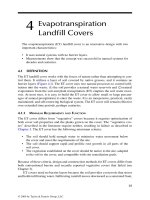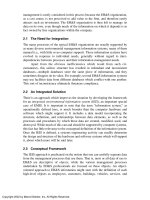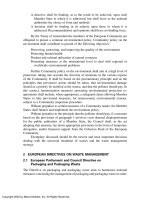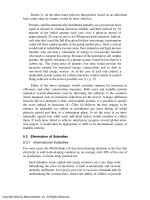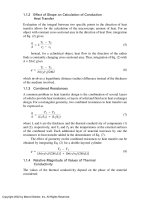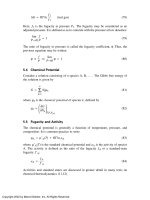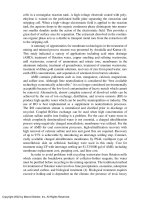Handbook Of Pollution Control And Waste Minimization - Chapter 4 doc
Bạn đang xem bản rút gọn của tài liệu. Xem và tải ngay bản đầy đủ của tài liệu tại đây (288.38 KB, 13 trang )
4
Legislative and Regulatory Issues
Toni K. Ristau
Public Service Company of New Mexico, Albuquerque,
New Mexico
1 OVERVIEW
In many respects, pollution prevention and waste minimization are less creatures
of legislative fiat than are many other areas related to waste management. In part,
this is due to the way that the legislative and regulatory waste management
framework developed in the United States (1). In the United States, the major
regulatory strategy for addressing wastes, particularly hazardous or toxic wastes,
is a “command-and-control” system imposed upon the regulated community from
the top down. By contrast, many pollution prevention initiatives are voluntary
efforts initiated by companies that seek to improve the “bottom line,” rather than
requirements imposed by a regulatory agency.
To understand the current emphasis on pollution prevention, one must have
an understanding of the history of the regulation of hazardous and toxic wastes.
Now that environmental management is maturing as a discipline, there is an
increasing recognition that pollution prevention and appropriate waste manage-
ment (including minimizing waste streams wherever possible) during a facility’s
operational life can greatly reduce the potential for costly remediation and
cleanup after operations are discontinued.
Copyright 2002 by Marcel Dekker, Inc. All Rights Reserved.
2 HISTORY
Much of the early legislative effort related to waste disposal or releases of toxic
substances was engendered by incidents such as Love Canal in New York State,
or the release of toxic gas from a factory in Bhopal, India. These incidents, which
were widely reported by the media, outraged the public and caused a demand for
Congressional action (2).
2.1 Love Canal and the Enactment of the Comprehensive
Environmental Response, Compensation and Liability
Act (“Superfund”)
The Love Canal hazardous waste disposal site became the center of attention of
the media, as well as the regulatory agencies, in the late 1970s and early 1980s,
and inspired the passage of the Comprehensive Environmental Response, Com-
pensation and Liability Act (CERCLA), also known as “Superfund.”
The Love Canal site was not originally constructed to be a waste disposal
facility. Originally, the Love Canal was to be the centerpiece of a “model city,”
and the use of the canal for waste disposal was not contemplated. The canal was
originally constructed by William T. Love at the easternmost edge of the town of
Niagara Falls, New York, in 1893. The canal was to be used to supply water to
generate a cheap and essentially unlimited supply of hydroelectric power for this
model community. The discovery and adoption of the use of alternating current
in the mid-1890s, which allowed electricity to be generated at some distance from
the point where the electricity was to be used, rendered Love’s plans for the canal
uneconomic, and Love’s dream for the canal was never realized. The abandoned
canal filled with rainwater and was used as a swimming hole and for winter ice
skating by the local community. In the 1940s, Hooker Chemical Company
obtained rights to the canal, and began to use the old canal as a dump for chemical
wastes from Hooker’s chemical manufacturing operations. Hooker Chemical
drained the old canal, lined it with clay, and used the old canal as a waste dump.
Between 1942 and 1953, an estimated 22,000 tons of chemical wastes, as well as
municipal wastes, were dumped at the site. When Hooker Chemical discontinued
active use of the site, the company capped the old canal with a thick layer of clay,
and covered the entire site with sod (3).
Hooker Chemical sold the dump site to the local board of education in 1953
for a nominal sum (one dollar), on the condition that the company would not be
liable for any problems related to the wastes that were disposed at the site. Though
the board of education was aware that the site had been used for the disposal of
hazardous and toxic wastes, a school was constructed at the site, as were
numerous houses. Though Hooker Chemical tried to stop the development on the
contaminated land, local governmental authorities ignored the warnings, and
allowed the construction at and adjacent to the old disposal site.
Copyright 2002 by Marcel Dekker, Inc. All Rights Reserved.
High groundwater levels in the Love Canal area, resulting from unusually
heavy rains and snowfalls during the 1970s, caused an increasingly serious
situation at the old disposal site. Drums and other containers began to surface as
the area over the old disposal facilities subsided, and ponded areas and other
surface waters near the site exhibited high levels of contamination. Residents of
some of the nearby houses noted that the basements were oozing an oily residue,
and there were numerous complaints of noxious chemical odors. An engineering
firm was hired to perform a study of the problems noted by the residents in the
Love Canal area, and to formulate recommendations on how to address the
problems. The engineering company recommended that the canal be covered with
clay, that sump pumps used by nearby residents to prevent flooding of basement
areas be sealed off, and that a tile drainage system be installed to control the
migration of wastes. As these measures would be costly, the city elected not to
implement the engineering recommendations. However, in some homes where the
levels of chemical residues and problems related to noxious odors were found to
be very high, the city had window fans installed.
Despite these minimal efforts by the city to address residents’ complaints,
evidence was mounting that the contamination from the old Love Canal disposal
site was causing more than just inconvenience for the residents of the area. In
March 1978, the New York State Department of Health initiated the collection of
air and soil samples from the homes and other facilities located at and near the
site. The department also conducted a health study of the 239 families who lived
nearest to the old canal. Alarmed at the preliminary results from the study, in
August 1978 the department issued a health order calling for the evacuation of
pregnant women and children under the age of two, recommending that residents
minimize the amount of time spent in the basements of their homes, and also
recommending that residents not eat vegetables and fruits grown in their home
gardens. Residents found themselves in the difficult situation of being unable to
continue occupying their homes, but, because of the increasing publicity regard-
ing the contamination, they were also unable to sell or rent their homes. Shortly
after the issuance of the health order, the State of New York agreed to purchase
the 239 homes closest to the old canal.
In 1979, subsequent to the evacuation of the 239 families living closest to
the old disposal areas, the Love Canal Homeowners Association commissioned
another study (the 239 families who had already been evacuated were not
included in this study). This study indicated that there were increases in miscar-
riages, still births, crib deaths, birth defects, hyperactivity, nervous breakdowns,
epilepsy, and urinary tract disorders in families living in the area. When the
Homeowners Association presented its study findings to state health authorities,
the significance of the findings were downplayed due to potential flaws in the
study methodology. However, the resultant public outcry ultimately caused
action to be taken at the national level. In October 1980, President Jimmy Carter
Copyright 2002 by Marcel Dekker, Inc. All Rights Reserved.
ordered a total evacuation of the community. The Love Canal residents had the
option of selling their houses to the government at fair market value, and moving
to a new location.
The public outrage related to the situation in which the hapless residents of
the Love Canal neighborhood found themselves resounded through the halls
of Congress, and Congress responded in 1980 by passing the Comprehensive
Environmental Response, Compensation and Liability Act (42 U.S.C. 9601
et seq.), also known as “Superfund.” Superfund, or CERCLA, provides a mech-
anism for investigating threatened or actual releases of hazardous substances
into the environment, identifying potentially responsible parties, and funding
the requisite technical and engineering studies to address the problems caused
by the hazardous substance release. In addition, the Superfund provides a
means of funding cleanup activities through the imposition of a tax upon petro-
chemical industries.
And what was the final outcome for the Love Canal neighborhood? In 1982,
the U.S. Environmental Protection Agency (EPA) completed studies of the
contamination residing in the soils, water, and air near Love Canal, and initiated
appropriate remedial action. The 239 homes that were located nearest the old
canal were demolished. The remaining homes that were purchased by the
government, and the neighborhood school, were renamed Black Creek Village,
and the sale of the decontaminated homes to new families commenced in 1990.
There are still approximately 22,000 tons of waste buried in the center of the
community; periodic testing of the air, water, and soils in the community assure
the safety of the new residents. Today, the Love Canal neighborhood has been
“recycled,” and Black Creek Village is again a vital, living neighborhood.
2.2 The Incident at Bhopal and the Emergency Planning
and Community Right-to-Know Act
In December 1984, about four years after the enactment of CERCLA, an incident
involving the release of the volatile and highly toxic gas, methyl isocyanate,
occurred in Bhopal, India. Methyl isocyanate gas was produced and used at the
Union Carbide plant there as an intermediate product in the manufacture of
pesticides. The pesticides manufactured at the facility were important in several
ways to the local and national economy; they are and were used to aid nations
such as India to increase crop yields and improve conditions for their populace
by providing a means to control insect pests (4).
When the Bhopal incident occurred in 1984, the gas, which burst from a
tank at the Union Carbide plant, spread over a large, densely populated area near
the plant. Many people died in their beds, and others died trying to escape the
foglike cloud of poison gas. There were thousands of dead and injured in the poor
and crowded neighborhoods near the plant; though local officials were unable to
Copyright 2002 by Marcel Dekker, Inc. All Rights Reserved.
immediately determine the total number of deaths, the official death toll was
ultimately computed to be almost 10,000.
Though this incident occurred in India, it garnered much attention
within the United States. An analysis of the factors that caused the inordinate
number of deaths and injuries indicated that much, if not all, of the suffering of
the local population could have been prevented had there been appropriate
emergency procedures and evacuation plans in place. Further, it appeared that
many of the local populace may have been able to protect themselves had they
but known what kinds of substances were being produced at the plant, and what
measures they themselves might be able to take in case of a leak or a release at
the plant.
As was the case when the Love Canal situation was brought to light by the
media, there was a huge public outcry, and demands for legislation to assure that
an incident like the tragedy at Bhopal would never happen in the United States.
Congress was considering amendments to CERCLA at this time, and Congress
responded by adding a new Title III to CERCLA as a part of the Superfund
Amendments and Reauthorization Act (SARA) (42 U.S.C. 11001 et seq.) This
new Title III was also separately titled as the “Emergency Planning and Commu-
nity Right-to-Know Act,” or EPCRA.
EPCRA, unlike the other portions of CERCLA, which are largely oriented
toward cleanup of abandoned hazardous or toxic waste sites, focuses on commu-
nity preparedness and reporting by industrial facilities to assure that national, state
local response authorities, as well as local communities, are aware of the
substances that are being utilized at industrial facilities within the community and
are prepared to respond if there is a release, spill, or leak from such facilities.
2.3 Solid and Hazardous Waste Management and the
Resource Conservation and Recovery Act
In contrast to legislation enacted as a reaction to environmental crises or
catastrophes, the regulation of facilities and activities related to solid wastes
(and of hazardous wastes as a subset of solid wastes), is conducted under
the provisions of the Resource Conservation and Recovery Act (RCRA) (42
U.S.C. 6901 et seq.). The RCRA is designed in substantive part to regulate the
day-to-day operation of solid and hazardous waste management facilities and
activities through a permitting and standards system. The RCRA also contains
provisions related to response from releases from active or inactive waste
management units.
Though the RCRA contains provisions related to both solid waste and
hazardous wastes, much of the regulatory attention in recent years has been on
the hazardous waste component of solid waste streams. A particularly impor-
tant set of provisions in the RCRA gave the EPA the authority to control
Copyright 2002 by Marcel Dekker, Inc. All Rights Reserved.
hazardous waste from “cradle to grave.” The EPA thus has regulatory authority
and control over the generation, transportation, treatment, storage, and disposal
of hazardous waste.
In 1984 and 1986, Congress passed major amendments to the RCRA. The
1984 amendments were known as the Hazardous and Solid Waste Amendments
(HSWA). The HSWA required phasing out land disposal of untreated hazardous
wastes. The HSWA also added increased enforcement authority for the EPA,
provided for more stringent hazardous waste management standards, and pro-
vided for a comprehensive underground storage tank program. The HSWA also
provided for corrective action for releases from solid and hazardous waste
management units (both active and inactive) at operational solid and hazardous
waste management facilities.
2.4 The Pollution Prevention Act of 1990 and a New Way
of Managing Hazardous/Toxic Waste Streams
In response to many commentators, who noted that the existing RCRA
and CERCLA regulatory frameworks in many cases provided disincentives to
recycling and other waste minimization activities, Congress passed the Pollution
Prevention Act (42 U.S.C. 13101 et seq.) in 1990. Opportunities for source
reduction as a method of minimizing pollution are often not realized because
the industries responsible for compliance with RCRA necessarily focus on treat-
ment and disposal of the hazardous wastes generated by their processes,
rather than on reducing the overall use of hazardous or toxic chemicals in
their processes.
Unlike the RCRA and CERCLA, which provide at best indirect liability-
driven disincentives to the use and production of toxic and hazardous sub-
stances and wastes, the Pollution Prevention Act attempts to focus public,
governmental, and industry attention on reducing the amount of pollution
produced, by encouraging cost-effective changes in production, operation,
and raw materials use (known as “source reduction”). Source reduction requires
solid and hazardous waste generators to concentrate on fundamental process
changes to prevent waste (particularly hazardous waste) from being generated
in the first place, rather than regarding hazardous waste streams as a necessary
concomitant to industrial production and focusing on the treatment and dis-
posal of that waste. Pollution prevention, as opposed to hazardous waste treat-
ment and disposal, emphasizes the use of production practices that increase
efficiency in the use of energy, water, or other natural resources. Pollution
prevention practices include recycling and internal reuse of waste streams, source
reduction through the minimization or elimination of hazardous or toxic sub-
stances as industrial inputs, and revision of industrial processes to minimize
thermal and other energy losses.
Copyright 2002 by Marcel Dekker, Inc. All Rights Reserved.
3 APPROACHING POLLUTION PREVENTION AS A
“SYSTEMS MANAGEMENT” PROBLEM
There has been growing recognition that treating pollution prevention and energy
efficiency as fundamental process inputs, rather than as “add-on” or “end-of-
pipe” systems, is a much more effective way of minimizing the environmental
impact of industrial operations. This approach requires a refocusing of environ-
mental management efforts from a reactive, compliance-based mode to a pro-
active, preventative approach. This model, which recognizes and works within
productive industrial processes, rather than working against fundamental indus-
trial process and adding operational complexity as well as costs, is beginning to
find acceptance not only within industry, but within the EPA and equivalent state
and local regulatory agencies in the United States.
Alternative approaches (such as the systems management approach) have
been increasingly embraced by the international economic community as a
more rational method of assuring that pollution effects are minimized but that
needed industrial growth and development is not hindered. These alternative
approaches are increasingly seen as a way of assuring that industry is not only
economically efficient, but is “environmentally efficient” as well. The new
emphasis on resource conservation and waste minimization accomplishes both
goals—it minimizes the use of raw materials and energy required to maximize
production (and thus lowers production costs), and it minimizes the environmen-
tal impacts from the extraction and production of energy and other raw materials
as well as minimizing the impacts from waste disposal (and thus lowers the
overall environmental impact of industrial development and growth).
3.1 The Environmental Management System Approach
The development and use of an environmental management system within a
company, a facility, or an activity is one method of treating environmental
management as a systems management/systems optimization approach. One such
method that is gaining increasing acceptance in the United States as well as
internationally is the environmental management system development and certi-
fication process embraced by the International Standards Organization (ISO).
The environmental management system standards are codified in the ISO 14000
standards (5).
The standards are developed by internationally based technical committees.
Each nation is free to adapt the standards as appropriate to fit each country’s
unique political and resource considerations. Within the United States, the stan-
dards, once adopted, are modified and implemented through U.S based organi-
zations such as
American National Standards Institute (ANSI)
Copyright 2002 by Marcel Dekker, Inc. All Rights Reserved.
Underwriters Laboratories (UL)
American Standard Testing Methods (ASTM)
These U.S based standard-setting organizations conform the international
standards with U.S. regulatory requirements and assure that the overall objectives
of the standards can be met within the constraints of the U.S. political and
regulatory system.
The environmental management systems approach is beginning to make
headway in the United States. However, the “drivers” for adoption of ISO
performance standards and/or certification are not as well developed as in
other countries, where ISO certification may be a prerequisite for doing business
in that country.
The basic principles of environmental management systems are not unique
to any one type of business or industrial activity, but have applications in all
activities where the environment may be affected. The definition of an “environ-
mental management system” (EMS) is: “ . . . that part of the overall management
system which includes organizational structure, planning activities, responsibili-
ties, practices, procedures, processes and resources for developing, implementing,
achieving, reviewing, and maintaining the environmental policy.” The basic
principles of environmental management systems include:
Integration of environmental issues with other business issues
Looking at the environmental conundrum as an interactive system, rather
than as “add-ons” of discrete activities
The ISO 14000 Environmental Management Standards include several
standards that can be applied in the management of any company’s environmental
aspects of “doing business.” The ISO 14000 substantive standards for environ-
mental management include the following:
ISO 14001, Environmental Management Systems: Specification with Guid-
ance for Use
ISO 14004, Environmental Management Systems: General Guidelines on
Principles, Systems, and Supporting Techniques
ISO 14010, Guidelines for Environmental Auditing: General Principles
ISO 14011, Guidelines for Environmental Auditing: Audit Procedures for
Auditing Environmental Management Systems
ISO 14012, Guidelines for Environmental Auditing: Qualification Criteria
for Environmental Auditors
ISO 14024, Criteria for Certification Programs: Criteria for Self-Certification
and Third-Party Certification
Each company or facility is free to develop its own environmental manage-
ment system. The company selects and develops its own environmental perform-
Copyright 2002 by Marcel Dekker, Inc. All Rights Reserved.
ance objectives. In the United States, regulatory agency participation is not
required, but is encouraged. If the regulatory agency chooses to participate, the
agency will provide advice to the company in the setting of overall environmental
performance objectives. Ideally, the company then selects how to meet those
objectives, rather than being subjected to prescriptive control technology require-
ments (however, in the United States, this interactive systematic approach is not
currently allowed for within the existing regulatory framework).
Though the company is free to identify the components of its own environ-
mental management system, certain components must always be present if the
company wishes to seek certification of its environmental management system
under ISO 14000. These required environmental management systems compo-
nents are as follows.
Environmental policy: Senior management must define the corporation’s
environmental policy and ensure that the policy includes, among other
matters, a commitment to continual improvement, to pollution preven-
tion, and to compliance with relevant regulatory requirements.
Planning: The company must establish and maintain a procedure to identify
environmental impacts of its activities, as well as the legal and other
requirements. The corporation must establish and maintain documented
environmental targets and objectives, as well as environmental manage-
ment programs for achieving its objectives.
Implementation: Roles, responsibilities, and authorities must be defined,
documented, and communicated. The corporation must provide appropri-
ate training and must establish and maintain procedures for proper
communication. The company must have proper documentation of pro-
cedures, document control, operational control, and emergency prepared-
ness and response (contingency planning).
Corrective action: The company must establish and maintain documented
procedures to monitor and measure operations and activities that impact
on the environment, and must have documented procedures for investi-
gating nonconformances and implementing appropriate corrective ac-
tion. Procedures must be in place for identifying, maintaining, and
disposing of environmental records, and for periodic audit of the EMS.
Management review: Senior corporate management must review the EMS
on a periodic basis (and document its review) to ensure that the EMS is
suitable, adequate, and effective in meeting the company’s environmental
performance goals.
3.2 Tools Available for Employing Alternative Approaches
The EPA has, in recent years, become more interested in encouraging the
voluntary development of systems approaches to environmental management,
Copyright 2002 by Marcel Dekker, Inc. All Rights Reserved.
including pollution prevention versus “end-of-pipe” controls. The EPA now
provides Web-based information and tools for companies or entities that wish to
pursue pollution prevention or environmental management systems initiatives (6).
The EPA’s Office of Enforcement and Compliance Assistance has produced
“Sector Notebooks” for the following industry sectors:
Agricultural Chemical, Pesticide and Fertilizer Industry (1999)
Agricultural Crop Production Industry (1999)
Agricultural Livestock Production Industry (1999)
Aerospace Industry (1998)
Air Transportation Industry (1997)
Dry Cleaning Industry (1995)
Electronics and Computer Industry (1995)
Fossil Fuel Electric Power Generation Industry (1997)
Ground Transportation Industry (1997)
Inorganic Chemical Industry (1995)
Iron and Steel Industry (1995)
Lumber and Wood Products Industry (1995)
Metal Casting Industry (1997)
Metal Fabrication Industry (1995)
Metal Mining Industry (1995)
Motor Vehicle Assembly Industry (1995)
Nonferrous Metals Industry (1995)
Non-Fuel, Non-Metal Mining Industry (1995)
Oil and Gas Extraction Industry (1999)
Organic Chemical Industry (1995)
Petroleum Refining Industry (1995)
Pharmaceutical Industry (1997)
Plastic Resins and Man-made Fibers Industry (1997)
Printing Industry (1995)
Pulp and Paper Industry (1995)
Rubber and Plastic Industry (1995)
Shipbuilding and Repair Industry (1997)
Stone, Clay, Glass and Concrete Industry (1995)
Textiles Industry (1997)
Transportation Equipment Cleaning Industry (1995)
Water Transportation Industry (1997)
Wood Furniture and Fixtures Industry (1995)
The notebook contents, which can be viewed online and can also be downloaded
and printed out, include the following types of information for each industry
sector (7):
Copyright 2002 by Marcel Dekker, Inc. All Rights Reserved.
A comprehensive environmental profile
Industrial process information
Pollution prevention techniques
Pollutant release data
Regulatory requirements
Compliance/enforcement history
Government and industry partnerships
Innovative programs
Contact names
Bibliographic references
Description of research methodology
These sector notebooks focus on key indicators, including air, water, and land
pollutant releases typical of the industry sector, and are a good source of
information for managers who wish to implement pollution prevention or envi-
ronmental management programs at their facilities.
3.3 “Project XL” and EPA Regulatory Reinvention Efforts
The EPA has long recognized that many of the media-specific environmental
regulations (i.e., regulations applicable to the pollution of air, water, or land) can
be counterproductive in that imposing more stringent standards or increasing
regulatory scrutiny for one medium (such as air) may minimize the amount of
pollution within that medium, but can actually cause increased releases to other
media. Several years ago, the EPA initiated a regulatory reform effort that allowed
regulated companies to propose multimedia projects meeting certain criteria to
allow trade-offs between media and to enable better environmental performance
overall within a facility. This regulatory reform effort, denominated “Project XL,”
allowed companies and other entities to propose projects that substitute perform-
ance based standards for the prescriptive, one-size-fits-all, standards that are often
imposed through the EPA’s media-specific regulatory programs.
The EPA required that pilot projects proposed by facilities, sectors, and
government agency projects meet the following criteria (8).
Environmental results. Projects that are proposed should he able to achieve
environmental performance that is superior to what would be achieved
through compliance with current and reasonably anticipated future regu-
lation. “Cleaner results” can be achieved directly through the environ-
mental performance of the project or through the reinvestment of the cost
savings from the project in activities that produce greater environmental
results. Explicit definitions and measures of “cleaner results” should be
included in the project agreement negotiated among stakeholders.
Cost savings and paperwork reduction. Projects that are proposed should
Copyright 2002 by Marcel Dekker, Inc. All Rights Reserved.
produce cost savings or economic opportunity, and/or result in a decrease
in paperwork burden.
Stakeholder support. The extent to which project proponents have sought
and achieved the support of parties that have a stake in the environmental
impacts of the project is an important factor in the selection of projects.
“Stakeholders” may include communities near the project, local or state
governments, businesses, environmental and other public interest groups,
or other similar entities.
Innovation/Multimedia pollution prevention. The EPA is looking for
projects that test innovative strategies for achieving environmental re-
sults. These strategies may include processes, technologies, or manage-
ment practices. Projects should embody a systematic approach to
environmental protection that tests alternatives to several regulatory
requirements and/or affects more than one environmental medium. The
EPA has a preference for protecting the environment by preventing the
generation of pollution rather than by controlling pollution once it has
been created.
Transferability. The proposed pilot projects are intended to test new ap-
proaches that could be incorporated into other agency programs or in
other industries, or other facilities in the same industry. The EPA is
therefore most interested in pilot projects that test new approaches that
could one day be applied more broadly.
Feasibility. The proposed project should be technically and administratively
feasible and the project proponents must have the financial capability to
carry it out.
Monitoring, reporting, and evaluation. The project proponents should
identify how to make information about the project, including per-
formance data, available to stakeholders in a form that is easily under-
standable. Projects should have clear objectives and requirements
that will be measurable in order to allow the EPA and the public to
evaluate the success of the project and enforce its terms. Also, the project
sponsor should about the time frame within which results will be
achievable.
Shifting of risk burden. In addition to the above criteria, the proposed
project must be consistent with Executive Order 12898 on Environmental
Justice. It must protect worker safety and ensure that no one is subjected
to unjust or disproportionate environmental impacts.
Several Project XL pilot projects were initiated by government agencies, as
well as private industry. Unfortunately, the Project XL program was subject to
heavy criticism from environmental groups as well as from government oversight
entities, and new projects are currently not being fielded.
Copyright 2002 by Marcel Dekker, Inc. All Rights Reserved.
REFERENCES
1. A good source of statutory material related to regulation of the environment can be
found on the Web at The regulations associ-
ated with the various laws and statutes are found at />In addition, the U.S. Environmental Protection Agency (EPA) Website contains
information on environmental laws and regulations that fall under EPA jurisdiction for
compliance and enforcement. The EPA home page, which contains an index and links
to other sources of information, is found at />2. For a summary of major pieces of legislation related to hazardous and toxic substances
and wastes, see />3. For a more detailed discussion of the history of the Love Canal, see http://www.
essential.org/orgs/CCHW/lovcanal/lcsum.html and />EnvRegs/eli/Love%20Canal%20Project.html.
4. For additional information regarding the incident at Bhopal, see http://
www.corpwatch.org/trac/bhopal/factsheet.html and />environment/disasters/industrial/bhopal/envreu19941204_00.html.
5. The International Standards Organization (ISO) was established in Geneva, Switzer-
land, in 1947. The purpose of the ISO was (and is) to develop uniform, worldwide
standards for the conduct of manufacturing and other industry, business, technical, and
commercial activities. At present, 92 countries belong to the ISO (representing more
than 92% of the world’s industrial production). At the international level, more than
200 technical committees have been developed. The ISO has, to date, established over
8500 standards.
6. The following EPA Website provides common-sense information, links, and tools
for pollution prevention and other environmental management systems approaches:
/>7. To view the sector notebooks online, see For
individual sector information, each listed sector is a “hot link” to more detailed
information for that sector. Also, an excellent set of Web-based resources related to
pollution prevention, waste minimization, and environmental management issues is
maintained by the U.S. Navy. These resources are available to anyone, and are found
at />8. See, for example, the Website for “Campus Pollution Prevention Information Resources,”
at />Copyright 2002 by Marcel Dekker, Inc. All Rights Reserved.

